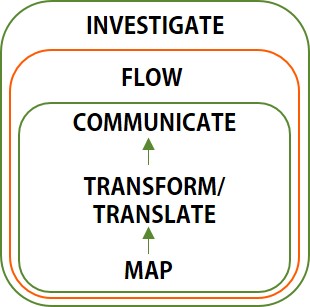I am continuing on my integration ladder with flow. My series started with Mapping - A Key Component Of B2B Integration, and continued with Transform And Translate - A Key Component Of B2B Integration, Communicate (Part 1) - A Key Component Of B2B Integration, and my last post, Communicate (Part 2) - A Key Component Of B2B Integration.
My definition of flow is the journey the data goes through from origination to destination.

Flow is where there are significant differences between solutions. Every integration solution has some sort of ability to automate and track the data, but each is unique in how it is done, how extensive it is, and how easy it is to do.
Gentran:Server UNIX
Gentran:Server UNIX has process flows that are created through the Process Control Manager or EC Workbench. These flows consist of one or more data managers that process the data (ex. translate, split file, archive). A process flow can consist of data managers and Gentran:Server scripts. Typical uses for scripts would be to initiate a communications session and copy or move files.
Gentran:Server Windows
Gentran:Server Windows Process Control allows you to build customized events to automate your message processing by creating sessions. A session script consists of a list of Gentran:Server functions that the system executes in the sequence listed. Examples of functions are rename or delete a file, print, and archive. You can specify parameters and conditions for each function to determine when and if a function is executed.
IBM B2B Integrator
B2B Integrator uses BPML (Business Process Modeling Language) which can be created using the Graphical Process Modeler (GPM) or code written in a text editor. In the GPM interface, you construct your business process models, coordinating the flow of activities in a graphical depiction of the ordered steps. The GPM provides icons representing the services, adapters, and Business Process Modeling Language (BPML) instructions that make up your process models.
IBM B2B Integrator Graphical Process Modeler Example

IBM Transformation Extender or ITX (formerly WebSphere Transformation Extender or WTX)
Transformation Extender Integration Flow Designer (IFD) is a modeling component that allows you to graphically manage data integration processes. It is part of the Transformation Extender Design Studio. The IFD specifies interactions between maps, coordinates multiple data sources and targets, and has the capability to link any text file or Windows-registered file type to map components for documentation purposes.
IBM Transformation Extender Integration Flow Designer Example

In addition, IBM Transformation Extender for Integration Servers packages extenders for other IBM products. Included in this product is IBM Transformation Extender for IBM Business Process Manager Advanced (formerly WebSphere Transformation Extender for Enterprise Service Bus). This extends the functionality of Business Process Manager Advanced to WebSphere Transformation Extender's universal transformation capabilities. IBM Business Process Manager Advanced is an integration design tool for visually constructing services, data transformations, and Business Process Execution Language (BPEL) orchestrations. This product is more robust and far reaching than Transformation Extender Integration Flow Designer.
WebSphere Data Interchange or WDI
WebSphere Data Interchange uses processing profiles and rules to direct and transform data, but the capabilities and scope are limited to functions within WDI.
WDI can also integrate with IBM Business Process Manager (formerly WebSphere Process Server or WPS).
In summary, the products that have a graphical representation of business processes are much easier to understand and use. These are newer products and have a broader range of coverage….you can create entire business processes, not just processes limited to EDI.
It's interesting to note that in the earlier products, such as Gentran and ITX, the ability to control the data flow was specific to the scope of the transformation product. As these products have evolved, they have become less specific to a particular system or business function and broad reaching to all things integration and messaging.
Another observation is that IBM has taken a modular approach with many of their solutions, it's what I call a separation of duties. As I was doing research for this blog, I got very confused by the overlapping product capabilities and name changes, but after looking at the information over and over, it seems they are slowly pulling out the best of each solution into a separate product, and then creating integrations among those products. Each product has a particular purpose, but they can integrate and work together. This gives companies the flexibility to pick and choose what they need, for a customized solution.


